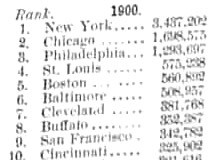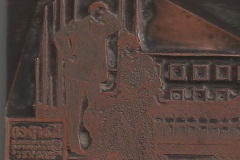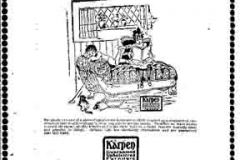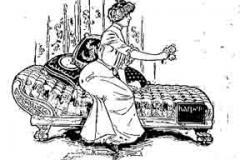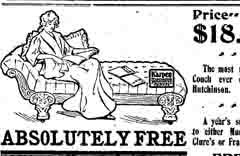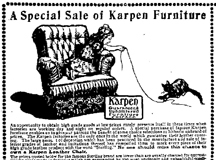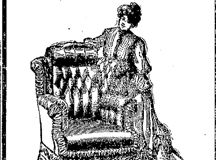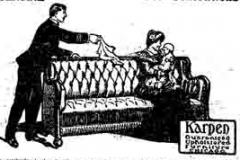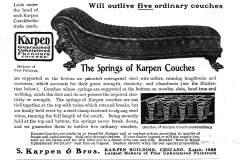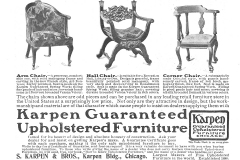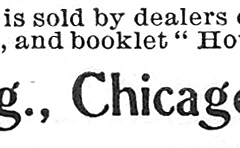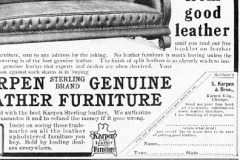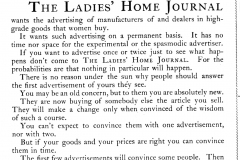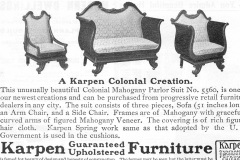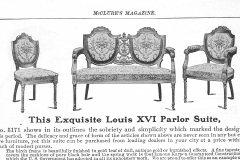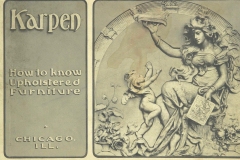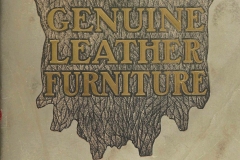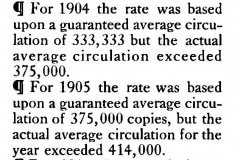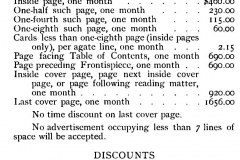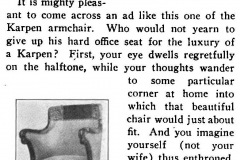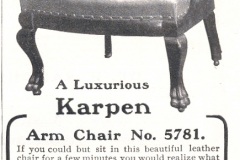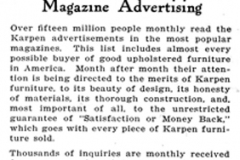Advertising to the Customer—Especially the Female Customer: 1900-1905
Sales we built gradually, as we built everything else, not by any high-priced notions about salesmanship, but simply by going where we thought business was to be had and showing what we were making and telling why we thought orders were due us. . . . A quarter of a century ago we pioneered in the furniture field by using a name plate and trademark on each piece. Advertising in national as well as trade fields has followed naturally.—Solomon Karpen in Neil Clark, “How Nine Brothers Built Up a $10,000,000 Business,” Forbes, August 1, 1926, 34.
In 1900, 47% of the 76 million people in the U.S. lived in incorporated areas, with 25.9% in places with 25,000 or more inhabitants. The urban growth between the East and West Coasts would provide major opportunities for S. Karpen & Bros. Adolph, Julius, and Solomon Karpen responded by expanding their Advertising and Marketing Department.
The purpose of the Karpen guarantee and trademark was to build name recognition and confidence in the consumer. To achieve that goal, the company had to reach potential customers directly. In 1900, it was most always left to the individual furniture retailer or dealer to advertise, and they did so just in the local newspapers. The electrotypes Karpen Bros. provided to its dealers were either clear depictions of furniture or family vignettes.
At the turn of the 20th century, popular magazines did carry advertisements for some products, like Ivory Soap, Quaker Oats, and clothing. There were very few advertisements for upholstered furniture, and those advertisements were direct sales to readers. Karpen Bros. led the furniture industry into new advertising age by promoting trade for the retail furniture dealer.*
Karpen Bros. placed its first advertisements in the national monthly magazines, Munsey’s Magazine and McClure’s Magazine, at the end of 1900. Although we are not familiar with these magazines today, in 1900 they were read by the growing rising- middle-class throughout the country. Munsey’s Magazine, founded in 1889, was “a magazine of the people and for the people, with pictures and art and good cheer and human interest throughout.” It included numerous illustrations and a complete novel in each number; each issue cost ten cents (eight cents/ per issue with a yearly subscription). Munsey’s Magazine had the sizeable circulation of 700,000;[1] with each issue being shared with family and friends, in 1900 the actual number of readers being counted as more than 3 million.[2] We can assume that female readers made up a sizeable segment of those figures.
McClure’s Magazine began in 1893 with a goal of dealing with important social, economic and political questions, featuring a biographical portrait in each issue. This illustrated magazine, with contributions by celebrated writers, sold for ten cents an issue to more than 400,000 people.[3]
These first advertisements included elements that highlighted the innovations Karpen Bros. had already put into its marketing plan. The Karpen trademark was prominently featured and the word “guarantee” was frequently used. Certainly, readers of the magazines were not familiar with Karpen furniture so the advertising copy answered the obvious questions: Who are we? “S. Karpen & Bros;” Where are we located? “Karpen Building, Chicago;” How long have we been in business? “Established 1880;” What do we make? “Largest Makers of Fine Upholstered Furniture.”
The most important question, “Where do I buy Karpen furniture?” is addressed repeated and clearly in the advertisements. “Sold only through dealers. If your dealer cannot or will not supply you, send us his name and we will refer you to a dealer who can and will. . . .” [4] A few months later, the lead headline answered the question directly: the furniture illustrated “can be purchased from any furniture dealer in the U.S. at a surprisingly low price.” [5] In the text, Karpen Bros. offered that “if your dealer hasn’t this identical [piece], he can order it for you from us.” [6]
The style of the advertisements in the popular magazines remained constant. A short, clear headline and one to six pieces of furniture were the focus points. The images were cuts taken from current catalogs and included details of each piece. The text varied in type size from quite readable to very small type. The lower section of advertisements included the trademarks, showroom information, and the taglines, “Established 1880.” and “World’s largest makers of fine upholstered furniture.” The tone of the advertisements was respectful and serious in keeping with the importance—and expense—of purchasing home furnishings.
Like other advertisers in the early 1900s, Karpen Bros. offered to send a free educational booklet. To track readership response, the reader was asked to request, for instance, “Book ‘W’” or “Book ‘A.M.’”
Karpen Bros. included a cut-out coupon (first used in 1887 by Coca Cola) to request booklets in only in a few advertisements.[7] The reasons why coupons were not used more frequently were perhaps they wanted to hear more personally and directly from its potential customers, or, since magazines were passed from reader to reader, no one wanted to cut a hole in a page.
What changed in Karpen Bros. advertising strategy was its dramatic expansion of the number of magazine advertisements it placed and the location of the advertisements. In 1900 and 1901, advertisements were placed in Munsey’s Magazine and McClure’s Magazine. In 1901 Ladies Home Journal and Harper’s Magazine were added. The national reach of these advertisements was huge. Curtis Publishing Co. advertised that in 1895 Ladies Home Journal’s readership (including paid [ca. 500,000] and pass-along) was 3.5 million readers.[8] And it continued to grow. The publishers of Ladies Home Journal explained the benefits to potential advertisers:
The advertisements were in advertising sections or towards the back of the magazines. In Munsey’s Magazine, McClure’s Magazine, and Harper’s Bazaar the advertisements were half a page, either vertical or horizontal. Those magazines measured 6.5 inches by 9.75 inches.
In its advertisements in consumer magazines, Karpen Bros. occasionally offered special discounts for certain months in connection with an advertising campaign.[9]
The advertisements educated the buying public—men, and especially women. In simple language and with diagrams, the advertisements in small print described the special qualities of Karpen Bros.’ springs and construction, woods and finishes, fillings, and upholstery fabrics. The advertisements did not avoid using period names, again educating the public.
Karpen Bros.’ booklets developed for the consumers were of high quality. How to Know Upholstered Furniture with 57 pages was published in 1900. Genuine Leather Furniture, with 64 pages was published in 1902 and Deception in Leather was published in 1903. Advertisements in magazines encouraged readers to write for its 64-page Genuine Leather Furniture “showing over 100 designs, and telling how you can be sure of getting the best genuine leather covered furniture.”[10]
In 1903, advertisements for the newly-invented and newly-marketed automobile brought even more attention to popular magazines. 1903 saw the introduction of Karpen Bros. advertisements in The Saturday Evening Post. [11] The owners of Ladies Home Journal acquired the ailing The Saturday Evening Post in 1897. While Ladies Home Journal was read only by women, the market niche of The Saturday Evening Post was middle-class to upper-middle-class men. However, from the beginning, that magazine was read by women as well. Saturday Evening Post’s circulation was 250,000 and rose to 1 million by 1908. It sold for 5 cents because its advertising revenue was substantial. It was over-sized at 10 inches by 13 inches with artistic 2-color covers. At first Karpen Bros.’ advertisements were in the main section of the magazine; then it paid extra to get placement inside the front cover. The advertisements were one-quarter page to one-half page.
Karpen Bros. also advertised in Leslie’s Monthly. Julius Karpen explained that “since we began with the Ladies Home Journal [in 1901] the campaign has grown gradually. We have always added–never reduced the list.”** It placed advertisements in these popular magazines 8-12 times a year. We do not know if this advertising plan was based on readership levels or advertising packages offered by different publishers.
On October 8, 1904, Karpen Bros. placed a two-page advertisement in the center pages of The Saturday Evening Post. Thirty pieces with style numbers and descriptions surrounded a small center text section. The furniture trade press reported the event:
One of the most remarkable features of a successful advertising campaign was the appearance on October 8 [1904] of a double page Karpen “ad” in The Saturday Evening Post. The expenditure for space for this single insertion was $2,800. . .. While the retail furniture dealers of the country have been consistently liberal advertisers, and have used expensive space, it is safe to say that this was the highest priced single advertisement ever used in the history of the American furniture trade, and probably of the world.[12]
In 1902 the first professional advertising critic Charles Austin Bates reviewed Karpen Bros.’ advertisements positively; Bates was the author of Good Advertising: And Where It Is Made (1896); weekly contributor to Printer’s Ink, an advertising trade journal; and publisher of his own advertising journal:[13]
Karpen Bros.’ effective direct advertising efforts that began in 1900 brought immediate results:
* “The Karpen Furniture Advertising,” Printers’ Ink: A Journal for Advertisers, November 16, 1904, 14.
**Julius Karpen Interview, “The Karpen Furniture Advertising,” Printers’ Ink: A Journal for Advertisers, November 16, 1904, 15.
- “Comparative Showing on the February Magazines,” Munsey’s Magazine, Mar. 1898, 956. ↑
- Munsey’s Magazine, Oct. 1900, 160. ↑
- McClure’s Magazine, 1906, 31-32. ↑
- McClure’s Magazine, Dec. 1900 and Munsey’s Magazine, Jan. 1901. ↑
- Munsey’s Magazine, Mar. 1901 and McClure’s Magazine, June 1901. ↑
- Munsey’s Magazine, Mar. 1901. and McClure’s, June 1901. ↑
- Munsey’s Magazine, July 1903. McClure’s Magazine, July 1903, p. 71. ↑
- Rob Shorman, Selling Style: Clothing and Social Change at the Turn of the Century. (Philadelphia: University of Pennsylvania Press, 2003, 63, 180 n. 46. ↑
- S. Karpen & Bros., Genuine Leather Furniture, 1902, (Chicago: S. Karpen & Bros., 1902), 05. ↑
- Munsey’s Magazine, Dec. 1902, advertising section. McClure’s Magazine, Dec. 1902, 7. ↑
- Saturday Evening Post, July 11, 1903, 15. ↑
- Furniture Trade Review, Dec.10, 1905, 112. ↑
- Mark Tungate, Adland: A Global History of Advertisement. (London: KoganPage, 2007, 2nd Edition, 2013), 12. ↑
